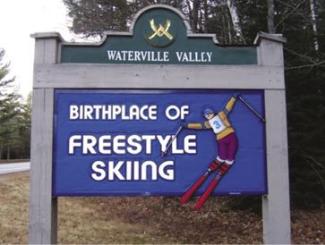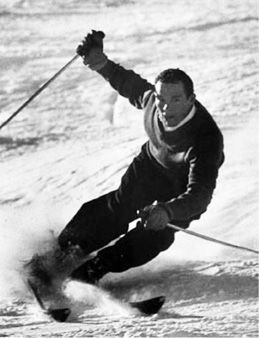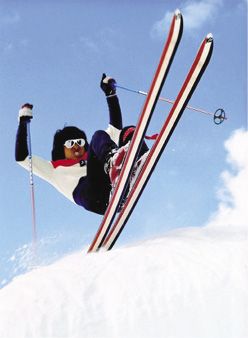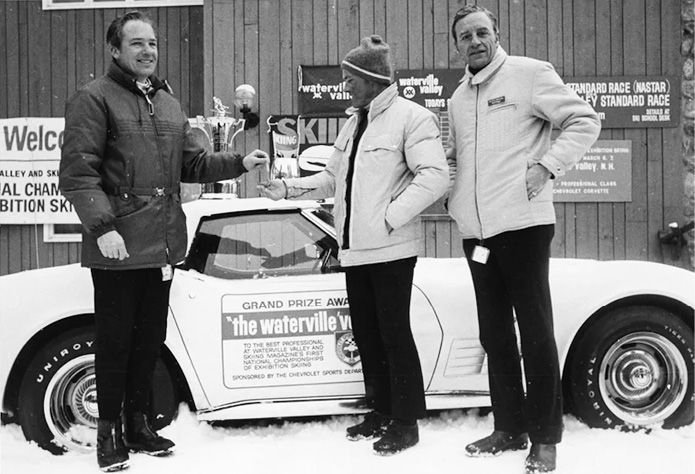Short Turns: Freestyle Returns to Waterville Valley

Hosting 2024 and 2025 FIS events, the resort reclaims freestyle's origin story.
As the story goes, in late 1970, two of skiing’s top influencers of that era were enjoying cocktails at an industry event in Boston and debating, naturally, who were the best skiers on any given day, on any given mountain.

Tom Corcoran, four-time national Alpine champion and two-time Olympian who founded New Hampshire’s
Waterville Valley Resort in 1966, was having a time with Doug Pfeiffer, the editor of Skiing magazine and an
iconoclastic ski instructor.
“Tommy said, ‘Obviously, it’s the ski racers,’” Wayne Wong explained at the John Fry Lecture during Skiing History Week in Park City. “And Doug Pfeiffer, who was one of the founders of PSIA, said, ‘Tommy, I beg to differ. What about the guys that are doing stunts and skiing bumps?’”
Corcoran wouldn’t hear it. So Pfeiffer pushed all of his chips in. “Doug said, ‘Put your money where your mouth is, Tommy. You’ve got a brand-new ski area. Here’s an opportunity to showcase Waterville Valley,’” Wong recalled. ‘“Let’s have a competition.’”
Challenge accepted. In 1971, Corcoran organized the Hot Dog Competition: National Championships of Exhibition Skiing at Waterville. It was arguably the first major freeskiing competition anywhere. And it even came with Chevrolet as a title sponsor. Wong recalled that there was a robust $10,000 in prize money and that the winner received a new Corvette. This was an offer that Wong and other elite—but often ignored—hotdoggers couldn’t refuse.

“I came all the way from Vancouver to Waterville Valley to compete in this event, not knowing really what I was getting myself into,” said Wong, who was 21 and needed to drum up $200 to make the journey. “Nobody knew what anybody was getting into at that time, because it was all, you know, the first time ever.”
The competition reflected the no-rules ethos of the hot-doggers. “There was a start gate and a stop gate,” Wong said. “And what you did in between was up to you to impress the judges.”
The timing was right. The event was a huge success, attracting thousands of spectators to True Grit, Waterville’s signature mogul run. The competition tapped into skiing’s growing rebel rejection of that era’s strict, Eurocentric standards of instruction and technique. “The establishment really was the Alpine ski racers. They were the stars of the ski industry,” said Wong. “All of a sudden, all these radical, rebellious, unorthodox guys were coming onto the scene and getting a lot of notoriety.”

Future U.S. Ski and Snowboard Hall of Famer Hermann Gollner took home the Corvette. Gollner, a former ski racer and beloved coach, was also a trained gymnast who had pioneered aerials on skis, so his victory didn’t exactly settle the question. Wong finished third. The future of freestyle looked bright.
And it seemed that freestyle skiing had found its natural habitat at Waterville Valley, which opened the first freestyle instruction program in the United States in 1969 and later launched the Boneyard, the first terrain park in New Hampshire. Yet despite a splendid record of supporting freestyle competitions and instruction programs over the past 50 years, along with being recognized as an early adopter of the freestyle revolution, Waterville Valley had never hosted an actual World Cup freestyle event.
Until last season. In January 2024, Waterville hosted the FIS Waterville Freestyle Cup, which included moguls and dual-moguls competitions. Better yet, the Freestyle Cup is scheduled to return to Waterville next season. The flashy “Birthplace of Freestyle Skiing” sign that has long welcomed visitors to the resort now has updated verification for its claim.
Wayne Wong attended the Freestyle Cup in January. History might not repeat itself, but it often does rhyme, as Mark Twain said.
“This World Cup is a great opportunity for Waterville, and to reinforce that this was the birthplace in the United States for freestyle skiing,” Wong told SKI magazine’s Brion O’Connor. “It’s all coming full circle.” 
Snapshots in Time
1926 SWISS ALPS BECKON
Many citizens of the United States are no doubt familiar with the scene at a Swiss mountain railway station during the Winter sports season. A real holiday feeling is in the air, the English language predominates, hotel and even railway porters displaying remarkable fluency, and even those who have been traveling twelve or twenty-four hours on a stretch, from Paris or London, begin to feel invigorated by the keen Swiss air and the friendly welcome they receive. The mountain railway end of the journey is usually enjoyed by all. The playground has been reached and dull care is left behind in the mists which frequently obscure the low-lying regions. — “Alps Winter Sports Attract Americans. Keen Air and Friendly Welcome in English Contribute to Visitor Enjoyment.” (New York Times, December 19, 1926)
1975 MYTH BUSTING
You have stereotyped housewives, students and secretaries (female occupations?) as sub-affluent groups compared to “well-heeled professionals” who frequent Vail (February, “Demographically, I Love You”). Bravo for perpetuating the myth and the phony elitism associated with skiing. We teachers are as hard-working and well-educated as any “professionals” earning more. — Shirley Hieber, Madison, Wis., Letters, “Professionals? Yawn” (SKI magazine, September 1975)
1989 NEVER DOWN
“One thing about real estate in Stowe is the price never goes down,” says Peggy C. Smith-MacDonald of Carlson Real Estate. “There are occasional sales from those investors who want to get out quickly, but even they will usually make money. During down periods, people hold on and prices make a lateral move for a year or two. In some cases, they drop down to their true market value, which is still usually more than the seller paid,” she said. What doesn’t exist in Stowe anymore “is your typical New England farmhouse on 25 acres for $60,000. Now it’s $550,000 or $850,000.” — Ann Lyons, “Stowe Real
Estate” (Snow Country magazine, July 1989)
1990 SNUFF IT!
“NO SMOKING” signs have gone up in the marketing offices of the Aspen and Jackson Hole ski areas, which have both decided to pull out of racing and other skiing programs sponsored by cigarette companies. Both concluded that tobacco is an inappropriate affiliation for a business linked with athleticism, family participation, good health, and clean air. A Marlboro Ski Challenge spokesman countered: “We are sponsoring skiing, not smoking.” But the two areas’ new policy may well signal the beginning of the end for smoke on the slopes. — Claire Walter, “More Tobacco Bans” (Skiing Magazine, October 1989)
2024 NO MOUNTAINS, NO PROBLEM
Marcel Hirscher, one of the most successful ski racers of all time, is planning to return next season after five years in retirement. And the record eight-time overall World Cup champion is going to compete for the Netherlands—his mother’s country—instead of his native Austria. The Austrian winter sports federation, known as the ŐSV, announced Wednesday that it had released the 35-year-old Hirscher and endorsed his nation change. While there have been Dutch skiers who have competed on the elite level, never has the Netherlands—a country with no mountains—had a top racer anywhere near Hirscher’s caliber. — Andrew Dampf, “Marcel Hirscher retired from skiing at the top. He’s back to race for a country with no mountains” (Washington Post, April 24, 2024)
